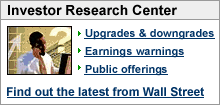|
Dow hits three-month high Blue-chip gauge closes at highest since May 11 on perfectly balanced job numbers; oil slips. NEW YORK (CNNMoney.com) -- Stocks kicked off September with a rally Friday that pushed the Dow industrials to their highest close in more than three months after a report pointed to solid-enough job growth to suit Wall Street and only mild wage inflation. The Dow Jones industrial average (up 83.00 to 11,464.15, Charts) jumped 0.7 percent, pushing the world's most widely watched stock market gauge to its highest close since May 11.
The broader Standard & Poor's 500 (up 7.19 to 1,311.01, Charts) added nearly 0.6 percent, and the Nasdaq composite (up 9.41 to 2,193.16, Charts) finished 0.4 percent higher. Oil slid more than $1, the dollar fell and Treasurys ended mixed. For the week, the Dow ended 1.6 percent higher, the Nasdaq finished 2.5 percent higher and the S&P 500 chalked up a 1.2 percent gain. "The path of least resistance right now is up," said John Wilson, managing director at the brokerage Morgan Keegan, noting trading volume was light before the holiday weekend. "All three traders are probably on the floor today," he joked. While next week will bring few economic reports, it should see trading volumes closer to normal as investors return from end of summer holidays. U.S. financial markets are closed Monday for Labor Day. Reports on tap for next week include a revised reading on productivity and activity in the services sector Wednesday, as well as wholesale inventories Thursday. The August job numbers were a big relief for investors since they showed both a strong economy and less inflation pressure. "It was pretty much a perfect number. It was not so strong the Fed will re-engage nor so weak you are concerned the economy is starting to stumble," Stephen Massocca, co-chief executive of Pacific Growth Equities, in San Francisco, told Reuters. Employers added 128,000 workers to payrolls last month, about in line with forecasts, while the unemployment rate dipped to 4.7 percent from 4.8 percent. The report's inflation indicator, average hourly earnings, rose a smaller than expected 0.1 percent. The report seemed to support recent hopes that the economic slowdown will not be as bad as has been feared, while the mild read on inflation helped relieve concerns that the Federal Reserve will resume its recently paused interest-rate-hike campaign. Also released in the morning: the University of Michigan's August consumer sentiment index, which was revised up to 82.0 from an initial read of 78.7, topping economists' expectations. The report also showed that expectations for the economy over the next 12 months worsened. Another report, the Institute for Supply Management's ISM manufacturing index, dipped to 54.5, from 54.7 in July. Economists surveyed by Briefing.com thought it would hold steady at 54.7. A reading above 50 points to growth in the sector. The read on July construction spending was less upbeat. Spending dropped 1.2 percent in the month, the government said Friday, versus forecasts for no change. Spending rose an upwardly revised 0.4 percent in June. What's moving? Blue-chip gains were broad based, with all but one of the Dow 30 rising. Blue-chip gainers included Alcoa (up $0.42 to $29.01, Charts), Caterpillar (up $0.92 to $67.27, Charts), AT&T (up $0.48 to $31.61, Charts), DuPont (up $0.51 to $40.48, Charts) and Wal-Mart Stores (up $0.73 to $45.45, Charts). Intel (up $0.31 to $19.88, Charts) gained 1.6 percent on speculation that it may cut up to 10 percent of its workforce as soon as next Tuesday. General Motors (up $1.09 to $30.27, Charts) gained 3.7 percent despite overall sales in August that fell short of estimates. The automaker reported about a 4 percent gain in U.S. sales, short of the 10 percent rise forecast by sales tracker Edmunds.com. Ford Motor (down $0.10 to $8.27, Charts) lost 1.2 percent after it said overall sales fell 12 percent in August. DaimlerChrysler (Charts) reported a 7 percent rise in U.S. sales for its luxury Mercedes brand, but its core Chrysler Group unit saw a 4 percent drop, leading to a 3 percent drop in sales overall. Edmunds had expected Chrysler to post a 12 percent decline in sales in the month. Daimler shares rose less than 1 percent in New York. Bristol-Myers Squibb (up $1.20 to $22.95, Charts) jumped after a U.S. judge agreed late Thursday to block the sale of a generic form of the Plavix blood thinner it markets with French partner Sanofi-Aventis (up $0.42 to $45.37, Charts). But the judge denied a motion to recall supplies of the generic version that have already been distributed by a Canadian company. That caused Sanofi to cut its 2006 profit forecast. Bristol shares gained 5.5 percent in active New York Stock Exchange trading. Sanofi's American depositary receipts gained almost 1 percent. OmniVision (down $1.21 to $15.39, Charts), a maker of image-sensor devices, sank 7.3 percent on the Nasdaq after warning late Thursday that second-quarter earnings and revenue won't meet estimates. Transocean (up $4.33 to $71.08, Charts), a drilling rig contractor, surged 6.5 percent in active New York Stock Exchange trading on late Thursday news that it won a five-year contract worth up to $862 million to build a drilling ship for Chevron (up $0.43 to $64.83, Charts). Market breadth was positive. On the New York Stock Exchange, winners beat losers 2 to 1 on volume of 1.12 billion shares. On the Nasdaq, advancers topped decliners by 5 to 4 on volume of 1.38 billion shares. U.S. light crude oil for October delivery fell $1.07 to settle at $69.19 a barrel on the New York Mercantile Exchange in a shortened session. Treasury prices ended a shortened session mixed, leaving the 10-year note yield at about 4.73 percent. Bond prices and yields move in opposite directions. In currency trading, the dollar fell versus the yen and euro. COMEX gold for December delivery fell $1.60 to settle at $632.60 an ounce. |
|





